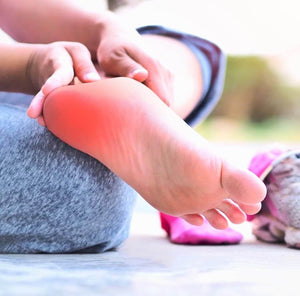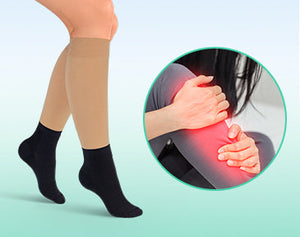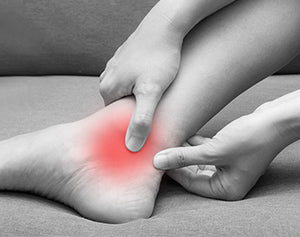The Orthofeet Blog
- All Posts
- Achilles Tendon Pain
- All
- Arch Support
- Arthritis
- Back Pain
- Bunions
- Diabetes
- Flat Feet
- Foot Pain
- Golf Shoes
- Hammer Toes
- Heel Pain
- Heel Pain/ Heel Spurs
- Knee & Hip Pain
- Knee pain
- Morton Neuroma
- Neuropathy
- Orthopedic shoes
- Other
- Overpronation
- Plantar Fasciitis
- Swollen Feet
Plantar Fasciitis


Josh White DPM / August 12, 2021
Hiking with Plantar Fasciitis: What You Need to Know
Hiking with Plantar Fasciitis: What You Need to Know
Read Post-
Can Stress Cause Burning Feet? Understanding the Connection
Medical information provided by Alea Becwar / February 18, 2025Ever felt like your feet were on fire, especially when life's getting a little too hectic? It's not just your imagination. Many people experience a strange burning sensation in their feet during times of stress or anxiety. But is there a real link between these two seemingly unrelated things and can stress cause burning feet? Let's explore the science behind this connection between mental stress and foot and ankle pain and what might be causing hot feet. What causes burning feet? Burning feet syndrome, or Grierson-Gopalan syndrome, is a condition where the feet become unusually hot and painful. If you're dealing with burning feet, it’s important to first understand the possible physical underlying cause. Here are some of the most common causes: Diabetic neuropathy Over time, high blood sugar damages nerves, especially in the feet, leading to symptoms such as a burning sensation, numbness, tingling, and sharp foot-ankle pain. Although stress doesn’t directly cause neuropathy, it can: Worsen nerve damage in people with diabetic or peripheral neuropathy Increased blood sugar levels, potentially accelerating nerve damage Lead to unhealthy habits (smoking, alcohol, poor diet) that damage nerves even further Alcohol use Excessive alcohol use can damage nerves, causing burning pain and weakness in the feet. Nutritional deficiencies Lack of essential vitamins, particularly B vitamins, can lead to nerve damage and burning feet. Small fiber neuropathy Damage to small nerve fibers can cause painful burning sensations in the feet. Athlete’s foot This fungal infection can cause symptoms like itching, burning, and peeling skin on the feet. Hypothyroidism An underactive thyroid can lead to peripheral neuropathy, contributing to burning feet. Peripheral artery disease (PAD) Narrowing of the arteries can reduce blood flow to the legs and feet, resulting in pain and burning sensations. Managing the underlying condition, such as controlling blood sugar in diabetes, can significantly reduce symptoms and prevent further complications. The link between stress and burning feet The short answer to the ‘Can stress cause burning feet?’ question is yes. Stress plays a surprisingly significant role in various bodily functions, including how our feet feel. Understanding the link between stress or anxiety and foot discomfort can help you manage symptoms more effectively. How stress affects the body Stress is a natural part of life and it affects the body in various ways. When we’re stressed, the body releases stress hormones like cortisol and this activates the ‘fight or flight’ response. This response redirects blood flow away from the legs, feet and ankles to vital organs like the heart and brain. This redirection means that the feet may not receive enough oxygen and nutrients, leading to symptoms like burning, tingling, or numbness. Stress also causes muscle pain and high tension throughout the body, including in the feet and ankles, which can lead to stiffness, chronic pain, and weakness. When muscle tension persists, it increases the risk of injuries such as plantar fasciitis or Achilles tendonitis. These conditions involve inflammation of tendons in the feet, which can cause pain and discomfort. Finally, when considering the question 'Can anxiety cause foot pain?', it's important to note that stress and anxiety can affect posture, leading to improper weight distribution on the feet and raising the risk of pain and injury, such as stress fracture. Stress-related symptoms in the feet But how exactly can stress cause burning feet? Although stress doesn’t directly cause burning feet, it can exacerbate existing conditions by affecting circulation and nerve function. Common stress-related symptoms in the feet include: Burning sensations: Reduced blood flow caused by stress can deprive the feet of nutrients and oxygen, leading to a burning feeling. Cold feet: As blood circulation is redirected to other parts of the body, stress can make your feet feel unusually cold. Numbness or tingling: Stress can also interfere with nerve signals in the feet, causing tingling or numbness. Increased risk of injury: Stress-induced muscle tension and poor posture can lead to conditions like plantar fasciitis and Achilles tendonitis, making the feet more prone to injury. Managing stress to alleviate foot symptoms If you’re wondering, 'Can stress cause burning feet?' it could be a sign that stress is starting to affect your daily life. But don’t worry, there are plenty of techniques and changes you can make to help both you and your feet feel less pressured. Here are some tips to help you get there. Stress reduction techniques Body awarenessClose your eyes and focus on the areas where you feel tension in your body. Take deep breaths and allow those areas to relax and release the tension. Breathing exercisesBreathing is one of the most effective methods for stress management. Focus on your breathing, taking slow, deep breaths to calm both your mind and body. Visual relaxationUse your imagination and visualize peaceful and calming experiences or moments to help you relax. You can also use guiding sources, such as apps or recordings if you find it easier. Imagine peaceful, calming moments to help you unwind. You can also use guided tools like apps or recordings if they make visualization easier. Meditation Concentrate on your breathing to bring your focus to the present moment, letting go of thoughts about the past or future. This can help reduce stress, anxiety and improve emotional well-being [5]. Ancient artsYoga, tai chi, qigong and other similar practices combine controlled breathing with movement to help you relax physically and mentally. If you experience health problems or are not used to physical activity, consult your doctor beforehand.Practices like yoga, tai chi, and qigong combine controlled breathing with movement to relax you both physically and mentally. If you have health concerns or aren't used to physical activity, check with your doctor before starting. Lifestyle changes for better foot health Stretch and strengthenGently stretch your toes, arches, and Achilles tendon to keep them flexible and ease pain. In addition, strengthening foot muscles with physical therapy exercises like toe curls or rolling a tennis ball under your foot can help prevent further issues and relieve even severe pain. IcingApplying ice to painful areas of your feet can help reduce swelling and discomfort. Ice the area for 15-20 minutes at a time. Healthy weightExtra weight means extra strain on your feet. Maintaining a healthy weight can help reduce foot pain. Physical activityLow-impact exercises that don’t put strain on your feet, like cycling and swimming, can keep you active and healthy without aggravating foot pain. Foot hygieneKeep your feet clean and dry to prevent infections and irritation. And don’t forget to moisturize. Recommended footwear for reducing foot discomfort The shoes you wear can make a big difference in your foot pain or discomfort, so it’s important to choose ones that provide support, cushioning, stability, and comfort. For those with conditions like neuropathy or diabetes, wearing properly fitted shoes for neuropathy or diabetic shoes can help protect sensitive feet, improve circulation, and reduce the risk of sores or injuries. Here are the features to look for in orthopedic shoes that’ll keep your feet supported and lessen painful symptoms throughout the day. Cushioned solesLightweight soles with multiple layers of impact absorbing materials and a mild rocker bottom do two things: they significantly reduce the strain on your feet to ease pain, and they promote smoother, easier motion, minimizing muscle fatigue. Orthotic insolesOrthotic insoles or inserts are designed with arch support to prevent overpronation (when your foot rolls inward, causing pain and discomfort) and to help correct your gait and the alignment of your feet with your body."Orthotic insoles help transfer a substantial portion of body weight to the arch, reducing pressure on the heel and ball of the foot," says Dr. Steven Gershman, DPM. Distributing weight more evenly across your foot not only helps minimize forefoot or heel pain but also reduces impact all the way up to your knees, hips, and back. Wide toe boxDr. Gershman explains that a wide toe box shoes gives your toes more room to move freely, “helping to prevent painful foot issues like bunions or hammertoe deformities.” Extra space at the forefoot also helps prevent cramping and the pain it causes. Variety of widthsEnsuring your shoes fit comfortably and properly is key to preventing foot pain, and that’s why it’s best to choose shoes that come in a wider variety of widths. “Unlike standard shoes, orthopedic shoes come in various widths to accommodate different foot shapes and sizes,” says Dr. Gershman. Extra depthIf you’re using custom shoe orthotics, your shoes need to accommodate them without squeezing your feet. Shoes with extra depth provide the space you need and also help minimize pressure points that can lead to pain or irritation. Stretch uppersStretchable upper materials adapt to the unique shape of your feet, preventing pressure and allowing your feet to swell throughout the day. "The stretch adjusts, giving you the feeling of a perfect fit at any time of day," comments Dr. Gershman. Protective interiorSmooth, soft interiors help prevent irritation, rubbing, and pressure points, which is especially important if you have sensitive feet or conditions like diabetes or neuropathy. Offering advanced orthopedic shoes for women and men's shoes for foot pain, Orthofeet is dedicated to enhancing your foot health and overall well-being. Our shoes are engineered with features like cushioned soles, orthotic insoles, and a wide toe box to alleviate discomfort and support active lifestyles. Step into comfort with Orthofeet and feel the difference in every step you take. Marjorie Hecht (medically reviewed by Alana Biggers, M.D., MPH). 15 Causes of Burning in the Feet. HealthLine. Updated on September 13, 2022. Accessed October 9, 2024. https://www.healthline.com/health/burning-in-feet Matthew Cotchett, Nicoletta Frescos, Glen A Whittaker, Daniel R Bonanno. Psychological Factors Associated with Foot and Ankle Pain: A Mixed Methods Systematic Review. PubMed Central. February 2022. Accessed October 9, 2024. https://www.ncbi.nlm.nih.gov/pmc/articles/PMC8812226/ Matthew Cotchett, PhD, Shannon E. Munteanu, PhD, Karl B. Landorf, PhD. Depression, Anxiety, and Stress in People With and Without Plantar Heel Pain. Sage Journals. May 2, 2016. Accessed October 9, 2024. https://journals.sagepub.com/doi/abs/10.1177/1071100716646630 Paul A Butterworth, Donna M Urquhart, Flavia M Cicuttini, Hylton B Menz, Boyd J Strauss, Joseph Proietto, John B Dixon, Graeme Jones, Anita E Wluka. Relationship Between Mental Health and Foot Pain. PubMed. August 2014. Accessed October 9, 2024. https://acrjournals.onlinelibrary.wiley.com/doi/epdf/10.1002/acr.22292 Julie Corliss. Six Relaxation Techniques to Reduce Stress. Harvard Health Publishing. February 2, 2022. Accessed October 9, 2024. https://www.health.harvard.edu/mind-and-mood/six-relaxation-techniques-to-reduce-stressRead More -
Stepping Confidently: What Are Slip-Resistant Shoes?
Medical information provided by Orthofeet Team / October 12, 2023Whether you're navigating a bustling kitchen, a sleek hospital corridor, a rain-slicked sidewalk, or any other surface that might be slippery or uneven, the need for stability and safety is universal. Luckily, we live in an era when the innovation of slip-resistant shoes already exists, helping to keep you on your feet when it matters most. So, what are slip-resistant shoes, how do they work and who should consider making them an essential part of their everyday wardrobe? Here’s everything you need to know about the footwear that allows you to walk confidently and securely. What are slip resistant shoes? Non-slip shoes, also known as slip resistant shoes, are specially designed footwear engineered with traction-enhancing soles and a slip-resistant sole to provide better grip on various surfaces. They are essential for: People who work in environments where slipping or falling poses a significant risk, such as restaurants, hospitals, industrial settings, or any place with wet, oily, or otherwise slippery floors. Explore the best shoes for healthcare workers with slip-resistant soles if you work in a related field. Older people, are typically more prone to slips and falls. Be sure to find the best walking shoes for seniors to avoid falls. Individuals working in environments with uneven surfaces, such as construction sites, or on slippery floors. Hikers, runners, and people who engage in other sports can benefit from improved grip and stability on various surfaces. Anyone seeking the peace of mind these shoes provide while walking or engaging in activities on their feet. What makes a shoe slip resistant? Slip resistant shoes are typically designed with a few key features: Outsoles with tread patterns shoes feature outsoles designed with specific tread patterns or rubber compounds that increase friction and prevent skidding. These tread patterns on slip-resistant shoes are strategically placed to enhance stability. The materials used in safety footwear construction are chosen for their slip-resistant properties to provide better traction than a regular shoe, offering even on slippery surfaces. These shoes are often designed to resist water, oil and other liquids, reducing the risk of slips in wet or greasy environments. In some cases, slip-resistant shoes may adhere to industry-specific safety standards to ensure they provide the necessary protection for particular work environments rather than everyday footwear. How do you know if you have slip resistant shoes? You can tell whether or not your shoes are slip resistant with a few simple steps: Look at the sole. Begin by looking at the sole of the shoe. A telltale sign of slip resistant footwear is a sole crafted from some type of high quality rubber. These materials provide traction, better grip, as well as cushioning and durability. Slip resistant soles are also rounded at the edges instead of being completely flat, so that liquids don’t get caught underneath. In addition, the soles of slip-resistant shoes are often thicker than those of standard shoes, especially if they are intended for work purposes. This added thickness contributes to increased support and foot protection. Look at the Tread. Pay close attention to the tread on the shoe's outsole, which should consist of grooves forming a specific pattern on the bottom of the shoe. These tread designs, while sometimes visually appealing, are primarily functional rather than decorative as they provide a better grip on slippery surfaces than everyday footwear. Look for patterns featuring small hexagons, circles, or squiggly lines, as these designs enhance the shoe's slip resistance by preventing liquids from getting trapped under the soles. As a general rule, a smaller and more pronounced tread pattern indicates better slip resistance. Try the shoes. The most important step is how you feel while wearing the shoes, so test them and see for yourself if they are slip resistant. Walk on a hard surface, such as tile or polished concrete, to check how effectively the shoe grips the floor. If you have the opportunity, try stepping on a slippery or wet surface to see how the shoe performs in such conditions.During your test, pay attention to other factors as well: the fit, support, cushioning and overall comfort of the shoes. Remember that while slip resistance is crucial, comfort is equally important, especially if you plan to wear the shoes for extended periods. Read the product description. Although it’s last on our list, checking the product description or tag is actually the easiest way to work out if your shoe is slip resistant or not. Look for phrases like ‘slip resistant’. These labels indicate that the shoe has undergone rigorous testing to meet slip resistant standards.Most manufacturers will not claim their products as slip resistant without valid certification, as it can have legal implications for the brand. Who should wear slip resistant shoes? Slip resistant shoes are often associated with specific occupational environments where slippery surfaces are a potential hazard. These environments include professions such as chefs and other restaurant workers, construction workers, janitors, vet techs, and healthcare workers. In fact, studies have shown that high rated slip resistant shoes minimized slip incidences by 37% and the occurrence of falls resulting from slips by 49% among Britain’s healthcare workers. However, the benefits of slip resistant shoes extend far beyond these work settings, making them a valuable addition to anyone's wardrobe. These shoes are not just about safety, but also about convenience and even style, offering advantages that can benefit people in various aspects of their lives. Imagine a typical day where you're running errands, going to the grocery store, or simply walking down the street. Suddenly, you encounter unexpected hazards like puddles, ice patches, or spilled liquids. In such situations, slip resistant shoes can prove to be a lifesaver. They provide an extra layer of protection against slips and falls, reducing the risk of injury. In addition, research found that slip resistant shoes can help older people avoid falls and slips. According to an article published in PubMed, “footwear influences balance and the subsequent risk of slips, trips, and falls by altering somatosensory feedback to the foot and ankle and modifying frictional conditions at the shoe/floor interface.” The article goes on to state that a comprehensive review of the existing literature found that older people should consider wearing shoes with sturdy slip-resistant soles, as well as low heels, both indoors and outdoors to enhance safety. The review also found that walking indoors without shoes or in socks and walking indoors or outdoors while wearing high-heeled shoes have been shown to elevate the likelihood of falls in seniors. Additional footwear design features like heel collar height, sol What do Slip Resistant shoes look like on the bottom? There are three main visible design features of the soles of non-slip shoes: There are three main visible design features of the soles of slip resistant shoes: A rubber sole, often made from EVA (ethylene vinyl acetate), which is a synthetic, foam-like resin frequently employed in the outsoles and midsoles of various shoes. This material enhances grip and traction significantly.For work shoes, the sole should also be thicker than normal, to provide improved support and protection. A well designed tread pattern, featuring elements like squiggles, circles, or hexagons, plays a crucial role in increasing the sole's surface area. This pattern effectively grips onto uneven surfaces, thus acting as a preventive measure against falls and injuries. In addition, the tread's frictional properties not only help secure your footing, but also prevent the accumulation of liquids underneath the sole, thus preventing slips. The sole is designed with a slight rounding at its edges, strategically designed to prevent the trapping of liquids beneath it. This feature, instead, facilitates the natural seeping out of any liquids encountered, further enhancing slip resistance. What's the difference between non-skid and slip resistant shoes? Non-skid, anti-skid, anti-slip and slip resistant are all terms used interchangeably to describe shoes designed to enhance surface grip, provide superior stability and help prevent slips, falls and injuries. Are all running shoes slip resistant? Not all running shoes are inherently slip resistant. In fact, most are not. The slip resistance of a running shoe depends on its design, sole material and tread pattern. Some running shoes are specifically designed for various terrains, including wet or slippery surfaces, and have slip resistant capabilities. Slip resistant does not mean compromise At Orthofeet, we firmly believe in not compromising on anything – be it comfort, safety, or style. Our slip-resistant shoes are meticulously crafted to provide advanced grip, stability, and optimal support for your feet, legs and back. We prioritize your health and wellbeing, ensuring that you can stay on your feet comfortably, even when standing all day. Every shoe we design, including those that offer slip resistance, comes complete with specialty features, such as customizable arch support, premium orthotic insoles, ergonomic soles, protective interiors and a spacious toe box, among others. And yes, they are as stylish as they are functional. Our slip resistant sneakers and work shoes feature an innovative tread pattern and high quality materials that deliver excellent traction on various surfaces, significantly reducing the risk of accidents and injuries. For more options crafted with your needs in mind, consider browsing our shoe collections. We offer styles such as women's wide shoes, arch support shoes, men's walking shoes, shoes for flat feet, and plantar fasciitis shoes. Basically, we take care of all things footwear, so all that’s left for you to do is confidently put your best foot (or rather feet) forward and focus on your activity, not your feet.Read More -
Best Running Shoes for Shin Splints
Medical information provided by Josh White DPM / April 11, 2023Shin splints can be a frustrating and painful condition—especially for runners and athletes who rely on their legs every day. Before we dive into our top shoe recommendations, let’s take a moment to clarify what shin splints really are, and why the right footwear can make a major difference. Shin splints refer to pain and inflammation along the shinbone (tibia), typically caused by repetitive stress on the lower leg. It’s a common overuse injury in runners, dancers, and athletes involved in high-impact activities. The discomfort usually stems from micro-tears in the surrounding muscles or inflammation in the connective tissues where those muscles attach to the bone. If you’re currently dealing with shin splints, the right running shoes can help relieve symptoms and support your recovery. Even better? The shoes featured below can also help prevent shin splints from developing in the first place by improving alignment, absorbing shock, and reducing muscle fatigue. Why Trust Our Recommendations? We understand that choosing the right shoe is more than a matter of comfort—it’s about your health. That’s why our recommendations are based on a combination of clinical insight, real-world testing, and customer feedback. Here’s how we approach our reviews: We consult with medical professionals, including podiatrists and physical therapists, to understand the biomechanical needs of those dealing with shin splints We wear-test each shoe ourselves, evaluating factors like fit, support, impact absorption, and long-distance performance. We collect real user feedback—especially from runners who experience shin pain or overuse injuries—to ensure our recommendations hold up in real-life conditions. Each shoe is carefully evaluated for key features that help prevent shin splints—like shock-absorbing midsoles, arch support, secure heel counters, and proper alignment to promote natural movement. This isn’t just a list—it’s a guide you can trust. Whether you're recovering from shin splints or looking to avoid them altogether, our curated selection is here to support every step. Best running shoes for shin splints for men Sprint [product-tile="/products/sprint-672-gray"] Why you’ll love it Tie-less lacing Fasten and unfasten on both sides of the shoes Specifications Sizes: 7-14 Widths: D-6E Upper materials: soft fabric and microfiber These shoes are designed with extra cushioning and support to help alleviate the pain and discomfort associated with shin splints, which means they are also the best walking shoes for men. They have a wide toe box to accommodate foot swelling and provide a comfortable fit. The Sprint also features a non-binding upper and an ergonomic sole to reduce pressure on the foot, and a roomy toe box that allows for natural toe splay, which can help to improve balance and stability while reducing the risk of foot and leg injuries. As an added bonus, the Sprint sneakers have no less than three adjustable straps - two on either side of the shoe and one at the back - that allow you to fully customize the fit, eliminate the need to tie and untie laces, and enables fastening and unfastening on both sides of the shoe. Sorrento [product-tile="/products/sorrento-brown"] Why you’ll love it Pressure free fit Increased durability Specifications Sizes: 7-14 Widths: D-4E Upper materials: soft leather and fabric The Sorrento sneakers are designed with an anatomical arch support that helps to reduce stress on the shin muscles and prevent overpronation, which is a common cause of shin splints. A thick layer of cushioning in the insole absorbs shock and reduces impact on the feet, helping to prevent the jarring and pounding that can lead to shin splints. With a lightweight and flexible design, the Sorrento allows for natural foot movement and reduces the risk of muscle strain and fatigue in the feet and legs. The width of the sole, coupled with the firmness of the heel counter, further enhances stability, as does the unique tread design that provides exceptional grip and provides an assured feeling of steadiness with every step. Yari [product-tile="/products/yari-hands-free-shoe-black"] Why you’ll love it Hands free foot insertion Water repellent uppers Specifications Sizes: 7-14 Widths: D-4E Upper materials: stretch knit Thanks to a unique hidden spring in the back of the shoe, you can put the Yari on without using your hands. By eliminating the need to bend down to put on or take off the shoes, these shoes can help reduce the strain on the muscles in the feet and legs, including the shins. This can potentially alleviate some of the symptoms of shin splints, such as pain and discomfort in the lower legs. Support is one of the most important features when it comes to finding shoes for shin splints, and Yari offers plenty of it. The cushioned insoles reduce impact on the feet and legs; the added arch support provides better stability and support, keeping over pronation at bay; and the cushioning outsole with a mild rocker design helps you walk with greater ease. The lightweight design allows you to walk with less effort, minimizing muscle fatigue in the feet and legs, and the upper’s breathable mesh material keeps the feet cool and dry. Best running shoes for shin splints for women Talya [product-tile="/products/talya-slip-resistant-white"] Why you’ll love it Slip resistant Water repellent uppers Specifications Sizes: 5-12 Widths: B-2E Upper materials: soft synthetic leather The Talya sneakers are made with professionals in mind and are designed with pain relief technology that’s perfect for people who spend long hours on their feet. The uppers are made from soft, high-quality, water and stain repellent faux leather that’s also flexible to provide a non-binding fit. The sole is slip resistant, so you can walk safely on any type of surface without losing your balance, which reduces the risk of slipping and falling. This is helpful if you have shin splints, as this condition is often caused by overuse of stress on the muscles and tendons in the shin area, and slipping or losing your balance can exacerbate the problem. In addition, by improving your grip and stability, slip-resistant shoes can help reduce the stress and strain on your lower leg muscles and tendons, which can alleviate the symptoms of shin splints. Coral [product-tile="/products/coral-stretch-knit-blue"] Why you’ll love it Breathable, aerated uppers Fully cushioned, yet lightweight Specifications Sizes: 5-12 Widths: B-2E Upper materials: stretch knit With multi-layered cushioning in the insole of the Coral sneakers, impacts on your feet and lower legs are significantly reduced and excessive pronation is prevented, helping to alleviate pain associated with shin splints. The Coral sneakers have a wide and deep toe box, which can provide extra room and reduce pressure on the toes and forefoot, improving overall foot comfort and reducing the risk of exacerbating shin splints due to cramped and tight shoes. In addition, the lightweight and flexible design can help promote a more natural and comfortable walking motion. This can reduce the strain and impact on the lower legs, minimizing the symptoms of shin splints. What all this means is that the Coral is not only great for running, but also the best walking shoes for women. Kita [product-tile="/products/kita-hands-free-shoe-black"] Why you’ll love it Easy on-off without bending Easy to clean, water-repellent uppers Specifications Sizes: 5-12 Widths: B-2E Upper materials: stretch knit The Kita sneakers are constructed with a number of features that can help alleviate pain associated with shin splints. The contoured orthotic insole provides arch support, which can help to distribute pressure evenly across the foot and reduce stress on the lower leg. The shoes also have a cushioned sole that can absorb shock and reduce the impact of each step, which can also help to reduce the pressure on the lower leg muscles. The innovative construction of the back of the shoe allows you to insert your foot without using your hands or even bending down, helping to minimize pressure and ease pain caused by shin splints in the lower legs. The insoles are expertly cushioned, including an anatomical arch support, and help to absorb shocks on the feet and legs as you walk. In addition, the mild rocker design improves the ease of walking. With the Kita sneakers on your feet, you can walk with less effort and minimize muscle fatigue in the feet and legs, while the uppers are made from a breathable mesh material that keeps the feet cool and dry. FAQ Can running shoes help with shin splints? Yes—supportive running shoes can reduce shin splint pain by absorbing shock and promoting better alignment. Look for stable soles, good arch support, and proper fit. They help manage factors like overpronation and poor foot mechanics. Can my shoes cause shin splints? Absolutely. Shoes that are worn out, lack support, or don’t fit properly can increase impact stress on your lower legs. Poor arch support and excessive heel drop may also affect your gait and lead to shin splints. Do cushioned shoes help with shin splints? Extra cushioning can ease pain by absorbing impact—but too much or the wrong type for your gait may worsen symptoms. Choose a shoe that balances cushioning with stability and support for your foot type. Should I walk or run with shin splints? Avoid running during flare-ups. Stick to low-impact activity like walking only if it’s pain-free. Once healed, return to running gradually with proper shoes and training adjustments. How do I treat shin splints? Start with rest, ice, and elevation to reduce inflammation. Use supportive shoes, avoid high-impact workouts, and do calf, ankle, and foot-strengthening exercises. If pain persists, consult a sports medicine professional. What should I look for in running shoes to prevent shin splints? Choose shoes with: Moderate to firm arch support Shock-absorbing midsoles A secure heel counter A comfortable fit based on your gait (neutral, overpronation, etc.) Bonus: Replace your shoes every 300–500 miles or when signs of wear appear. Who is most at risk for shin splints? You're more at risk if you: Have flat feet, rigid arches, or overpronation Suddenly increase mileage or intensity Run on hard surfaces Wear worn-out or improper shoes Have weak lower leg muscles or tight calvesRead More -
What are Orthopedic Shoes and Why You Should Wear Them
Medical information provided by Steven Gershman DPM / January 30, 2023To explain what orthopedic shoes are, we should first consider why we need to wear shoes at all. The reason, of course, is that shoes protect our feet from objects which may hurt us. They are an important barrier to foot injuries such as punctures, cuts, scrapes, burns and even frostbites. In addition, Dr. Steven Gershman, DPM, explains that shoes are ״like orthodontia for the teeth. Shoes can also change gait, alignment, and the biomechanics of the foot. Looking at pictures of feet in some societies that never wear shoes, you can clearly see feet that look dramatically different than the feet that wear shoes. Without shoes, the toes are separated in a way that looks like a hand.״ What is an orthopedic shoe? While wearing shoes offers protection and much more, it’s not enough just to wear any pair of shoes. In fact, wearing shoes that are poorly made or shoes with insufficient cushion or support that were designed for fashion but not function and comfort, can do more harm than good. Orthopedic shoes are designed with special features that support the feet and provide comfort and pain relief. This type of shoe can do wonders not only for feet, but also for your ankles, legs, and lower back. Orthopedic shoes designed for foot pain are specifically crafted to enhance foot health and alleviate discomfort, ensuring both improvement in conditions and reduction in pain. There are many different types of orthopedic shoes. Their design ranges for specific conditions, foot shapes and widths, activities, types of surfaces, etc. What are the benefits of orthopedic shoes? Each orthopedic design feature offers different unique benefits depending on the foot shape. Some features are always important and should be present in any orthopedic shoe (like the ones we have shared below), while others are more specific for those with sensitive feet, heel spurs, or chronic foot pain. Arch support Orthopedic shoes feature orthotic insoles that provide good arch support. The main purpose of the arch support is to eliminate excessive pronation, which affects foot function and is one of the main causes of foot and heel pain. Orthotic insoles help reduce pressure on the heel and the ball of the foot, by transferring a substantial portion of body weight to the arch. This will reduce discomfort caused by improperly aligned, painful feet and ankles. In shoes without good arch support, the arch area doesn’t participate in distributing the pressure under the foot. Excessive pronation causes the leg to rotate internally rotate, putting stress on the knee, hip, and lower back. Orthotic insoles with good arch support play an important role in alleviating stress on the knees, hips, and lower back, improving foot and leg alignment. Variety of widths Contrary to most shoes that are designed for the average foot and are available in medium widths, orthopedic shoes are made in a variety of widths to offer a precise fit and accommodate more foot sizes, shapes and problems. Most of these wide-toe box shoes are available in medium, wide and extra wide, but you can also find shoes in narrow and extra extra wide sizes. Extra depth Orthopedic shoes are constructed on a special shoe last with extra depth, to accommodate thick insoles and orthotics. They also offer a relaxed, comfortable fit, which eliminates pressure points on the foot. A bonus for those who love wearing thick cushioned socks that require more space. Wide toe box A wide toe box offers pressure relief for bunions and hammertoe deformities and allows extra room for toe movement. Learn about the different types of bunions and how to naturally shrink bunions to improve foot comfort. Protective interior Orthopedic shoes are normally made with a soft, smooth interior, designed to provide gentle contact with the foot and eliminate pressure points. Some are even seam-free, preventing irritation to sensitive feet. Stretchable uppers A stretchable upper design allows the upper area of the shoe to stretch and shape to the contours of the foot, easing pressure on bunions and hammertoes, and eliminating pressure points on the foot. Plus, if your feet tend to swell throughout the day, the stretch adjusts itself so it feels like you bought two different shoe sizes! Special Soles Orthopedic shoes are made with lightweight soles and a mild rocker bottom design that softens impacts and helps facilitate foot motion. In addition, a wide sole design enhances stability while walking. To summarize, orthopedic shoes offer many advantages compared to ordinary shoes: Help alleviate pain at the heels, feet, knees, hips and lower back. Improve mobility and stability. Provide a better fit. Provide essential protection for those with diabetes, neuropathy and other foot conditions. When should you wear orthopedic shoes? The word “orthopedic” is formed from two Greek roots: ortho, which means correct; and pedic, which means foot. Therefore, the two roots together mean “correct foot”, so orthopedic shoes are literally good for your feet by definition! In other words, wearing orthopedic shoes is highly recommended for people with foot problems - such as hammertoes, bunions, flat feet, arthritis, overpronation, heel pain, plantar fasciitis, and more. Our extensive selection includes specific designs for various conditions, such as flat foot shoes, shoes for bunions, and diabetic footwear. Even if you don't currently have foot issues, orthopedic shoes can still be beneficial. They are engineered to promote proper foot motion, provide support and cushioning, alleviate pain, and help prevent future foot conditions. Discover how our men’s orthopedic shoes and orthopedic shoes for women can enhance your foot health and comfort today!Read More







